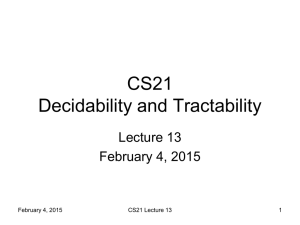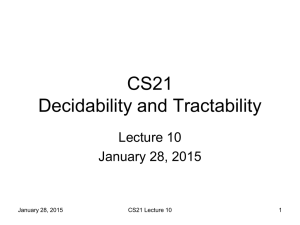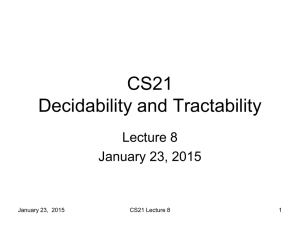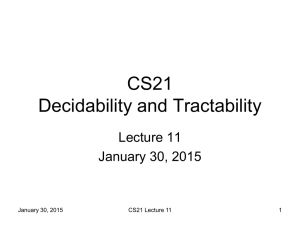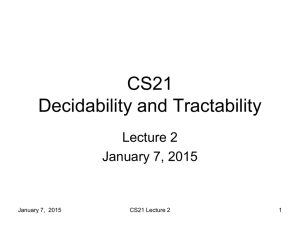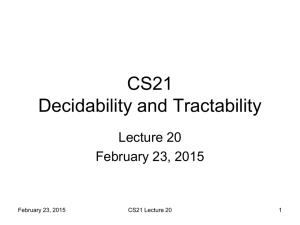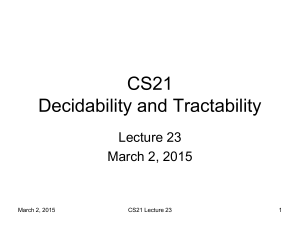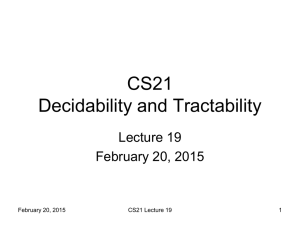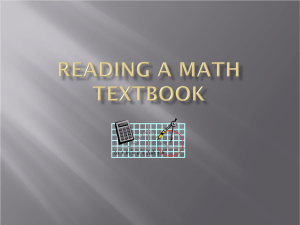CS21 Lecture 1 - Computing + Mathematical Sciences
advertisement
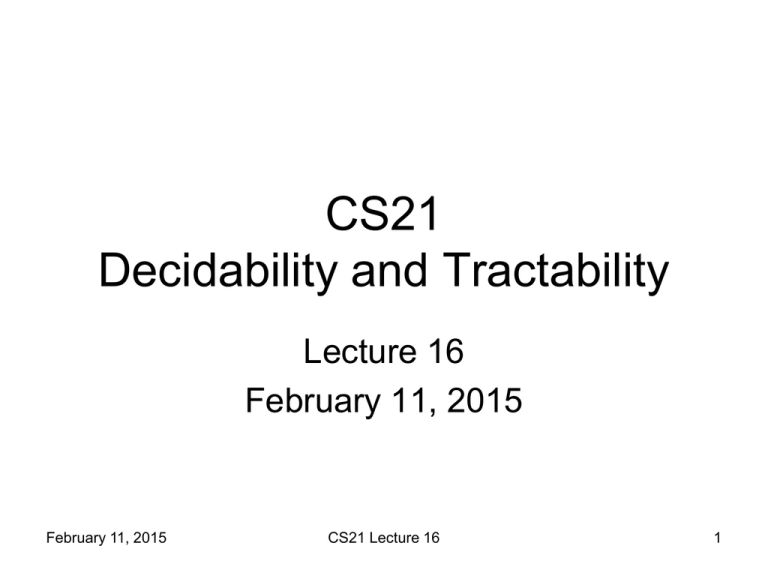
CS21
Decidability and Tractability
Lecture 16
February 11, 2015
February 11, 2015
CS21 Lecture 16
1
Outline
•
Gödel Incompleteness Theorem
•
on to Complexity…
February 11, 2015
CS21 Lecture 16
2
Gödel Incompleteness Theorem
February 11, 2015
CS21 Lecture 16
3
Background
• Hilbert’s program (1920’s):
– formalize mathematics in axiomatic form
– derive all true statements “mechanically” from
initial axioms
– would put mathematicians out of business!
– very influential proposal
• to start: try for all true statements about
the natural numbers (“number theory”)
February 11, 2015
CS21 Lecture 16
4
Background:
• Kurt Gödel (1931): it is not possible!
• no formalization of number theory can
prove all true statements
• stunning result
• considered one of greatest 20th century
achievements in mathematics
February 11, 2015
CS21 Lecture 16
5
Background
• We will prove using:
– RE languages and non-RE languages
– reductions
• Idea:
– set of all theorems is RE
– set of all true statements is not RE
• This kind of proof of Gödel’s result
attributed to Turing (1937).
February 11, 2015
CS21 Lecture 16
6
Number Theory
• formal language to express properties of
N = {0, 1, 2, 3, …}
• allowable symbols: parentheses, and
–
–
–
–
–
–
variables x,y,z,… ranging over N
operators + (addition) and * (multiplication)
constants 0 (additive id) and 1 (mult. identity)
relation = (equality)
quantifiers (for all) and (exists)
propositional operators (and) (or) (not)
(implies) (iff)
February 11, 2015
CS21 Lecture 16
7
Number Theory
• can formalize syntax of allowable formulas
(skip)
• defining comparison relations:
– x ≤ y z x + z = y
– x < y z x + z = y (z = 0)
February 11, 2015
CS21 Lecture 16
8
Number Theory
• Other natural concepts we will need:
– quotient q and remainder r when divide x by y
INTDIV(x, y, q, r) x = qy + r r < y
– y divides x
DIV(y, x) q INTDIV(x,y,q,0)
– x is even
EVEN(x) DIV(1+1, x)
– x is odd
ODD(x) EVEN(x)
February 11, 2015
CS21 Lecture 16
9
Number Theory
• Other natural concepts we will need:
– x is prime
PRIME(x) x ≥ (1+1) y (DIV(y, x) (y = 1 y = x))
– x is a power of 2
POWER2(x) y (DIV(y, x) PRIME(y)) y = (1+1)
– y = 2k and kth bit of x is 1
BIT(x, y) POWER2(y) q r (INTDIV(x, y, q, r)
ODD(q))
February 11, 2015
CS21 Lecture 16
10
Number Theory
– y = 2k and kth bit of x is 1
BIT(x, y) POWER2(y) q r (INTDIV(x, y, q, r)
ODD(q))
y=
x=
10000000000
1010111010111001001001
q
February 11, 2015
r
CS21 Lecture 16
11
Number Theory
• A sentence is a formula with no unquantified variables
– every number has a successor:
x y y = x + 1
– every number has a predecessor:
x y x = y + 1
– not a sentence: x + y = 1
true
false
• “number theory” = set of true sentences
– denoted Th(N)
February 11, 2015
CS21 Lecture 16
12
Proof systems
• Proof system components:
– axioms (asserted to be true)
– rules of inference (mechanical way to derive
theorems from axioms)
• axioms for manipulating symbols (e.g.):
– ( )
– (x (x)) (1+1+1)
– x y z (x = y y = z x = z)
– others…
February 11, 2015
CS21 Lecture 16
13
Peano Arithmetic
• Peano Arithmetic: proof system for
number theory. Axioms:
– 0 is not a successor
x (0 = x + 1)
– the successor function is one-to-one
x y (x+1 = y+1 x = y)
– 0 is an identity for +
x x + 0 = x
February 11, 2015
CS21 Lecture 16
14
Peano Arithmetic
– + is associative
x y x + (y + 1) = (x + y) + 1
– multiplying by zero gives 0
x x*0 = 0
– * distributes over +
x y x * (y + 1) = (x * y) + x
– induction axiom
((0) x ((x) (x+1))) x (x)
February 11, 2015
CS21 Lecture 16
15
Peano Arithmetic
• rules of inference:
modus ponens
generalization
February 11, 2015
x
CS21 Lecture 16
16
Proof systems
• a proof is a sequence of formulas
1, 2, 3, …, n
such that each i is either
– an axiom, or
– follows from formulas earlier in list from rules
of inference
• A sentence is a theorem of the proof
system if it has a proof
February 11, 2015
CS21 Lecture 16
17
Proof systems
• A proof system is sound if all theorems in
that proof system are true (better have this)
• Peano Arithmetic (PA) is sound.
true sentences
= Th(N)
false sentences
= co-Th(N)
theorems
of PA
February 11, 2015
CS21 Lecture 16
18
Proof systems
• A proof system is complete if all true
sentences are theorems in that proof
system
• hope to have this (recall Hilbert’s program)
true sentences
= Th(N)
false sentences
= co-Th(N)
theorems of a
complete proof
system
February 11, 2015
CS21 Lecture 16
19
Incompleteness Theorem
Theorem: Peano Arithmetic is not complete.
(same holds for any reasonable proof
system for number theory)
Proof outline:
– the set of theorems of PA is RE
– the set of true sentences (= Th(N)) is not RE
February 11, 2015
CS21 Lecture 16
20
Incompleteness Theorem
• Lemma: the set of theorems of PA is RE.
• Proof:
– TM that recognizes the set of theorems of PA:
– systematically try all possible ways of writing
down sequences of formulas
– accept if encounter a proof of input sentence
(note: true for any reasonable proof system)
February 11, 2015
CS21 Lecture 16
21
Incompleteness Theorem
• Lemma: Th(N) is not RE
• Proof:
– reduce from co-HALT (show co-HALT ≤m Th(N))
– recall co-HALT is not RE
– what should f(<M, w>) produce?
– construct such that M loops on w is true
February 11, 2015
CS21 Lecture 16
22
Incompleteness Theorem
– we will define
VALCOMPM,w(v) … (details to come)
so that it is true iff v is a (halting) computation
history of M on input w
– then define f(<M, w>) to be:
v VALCOMPM,w(v)
– YES maps YES?
• <M, w> co-HALT is true Th(N)
– NO maps to NO?
• <M, w> co-HALT is false Th(N)
February 11, 2015
CS21 Lecture 16
23
Expressing computation in the
language of number theory
– we’ll write configurations over an alphabet of
size p, where p is a prime that depends on M
– d is a power of p:
POWERp(d) z (DIV(z, d) PRIME(z)) z = p
– d = pk and length of v as a p-ary string is k
LENGTH(v, d) POWERp(d) v < d
February 11, 2015
CS21 Lecture 16
24
Expressing computation in the
language of number theory
– the p-ary digit of v at position y is b (assuming
y is a power of p):
DIGIT(v, y, b)
u a (v = a + by + upy a < y b < p)
– the three p-ary digits of v at position y are b,c,
and d (assuming y is a power of p):
3DIGIT(v, y, b, c, d)
u a (v = a + by + cpy + dppy + upppy
a < y b < p c < p d < p)
February 11, 2015
CS21 Lecture 16
25
Expressing computation in the
language of number theory
– the three p-ary digits of v at position y “match”
the three p-ary digits of v at position z
according to M’s transition function (assuming
y and z are powers of p):
MATCH(v, y, z)
(a,b,c,d,e,f) C 3DIGIT(v, y, a, b, c)
3DIGIT(v, z, d, e, f)
where C = {(a,b,c,d,e,f) : abc in config. Ci can
legally change to def in config. Ci+1}
February 11, 2015
CS21 Lecture 16
26
Expressing computation in the
language of number theory
– all pairs of 3-digit sequences in v up to d that
are exactly c apart “match” according to M’s
transition function (assuming c, d powers of p)
MOVE(v, c, d)
y (POWERp(y) yppc < d) MATCH(v, y, yc)
February 11, 2015
CS21 Lecture 16
27
Expressing computation in the
language of number theory
– the string v starts with the start configuration
of M on input w = w1…wn padded with blanks
out to length c (assuming c is a power of p):
START(v, c)
i = 0,1,2,…, n DIGIT(v, p , k ) p
i
i
n
<c
y (POWERp(y) pn < y < c DIGIT(v, y, k))
where k0k1k2k3…kn is the p-ary encoding of
the start configuration, and k is the p-ary
encoding of a blank symbol.
February 11, 2015
CS21 Lecture 16
28
Expressing computation in the
language of number theory
– string v has a halt state in it somewhere
before position d (assuming d is power of p):
HALT(v, d)
y (POWERp(y) y < d aHDIGIT(v,y,a))
where H is the set of p-ary digits “containing”
states qaccept or qreject.
February 11, 2015
CS21 Lecture 16
29
Expressing computation in the
language of number theory
– string v is a valid (halting) computation history
of machine M on string w:
VALCOMPM,w(v)
c d (POWERp(c) c < d LENGTH(v, d)
START(v, c) MOVE(v, c, d) HALT(v, d))
– M does not halt on input w:
v VALCOMPM,w(v)
February 11, 2015
CS21 Lecture 16
30
Incompleteness Theorem
v = 136531362313603131031420314253
VALCOMPM,w(v)
c d (POWERp(c) c < d LENGTH(v, d)
START(v, c) MOVE(v, c, d) HALT(v, d))
February 11, 2015
CS21 Lecture 16
31
Gödel Incompleteness Theorem
(an example
we didn’t get to in lecture)
February 11, 2015
CS21 Lecture 16
32
Incompleteness Theorem
v = 136531362313603131031420314253
d = 1000000000000000000000000000000
VALCOMPM,w(v)
c d (POWERp(c) c < d LENGTH(v, d)
START(v, c) MOVE(v, c, d) HALT(v, d))
d = pk and length of v as a p-ary string is k
LENGTH(v, d) POWERp(d) v < d
February 11, 2015
CS21 Lecture 16
33
Incompleteness Theorem
kkn…k2k1k0
v = 136531362313603131031420314253
c = 100000
n=1000
p
VALCOMP (v)
M,w
c d (POWERp(c) c < d LENGTH(v, d)
START(v, c) MOVE(v, c, d) HALT(v, d))
v starts with the start configuration of M on input w
padded with blanks out to length c:
START(v, c) i = 0,…, n DIGIT(v, pi, ki) pn < c
y (POWERp(y) pn < y < c DIGIT(v, y, k))
February 11, 2015
CS21 Lecture 16
34
Incompleteness Theorem
v = 136531362313603131031420314253
yc = 100000
y
=1
VALCOMP (v)
M,w
c d (POWERp(c) c < d LENGTH(v, d)
START(v, c) MOVE(v, c, d) HALT(v, d))
all pairs of 3-digit sequences in v up to d exactly c
apart “match” according to M’s transition function
MOVE(v, c, d) y (POWERp(y) yppc < d)
MATCH(v, y, yc)
February 11, 2015
CS21 Lecture 16
35
Incompleteness Theorem
v = 136531362313603131031420314253
yc = 1000000
y
=10
VALCOMP (v)
M,w
c d (POWERp(c) c < d LENGTH(v, d)
START(v, c) MOVE(v, c, d) HALT(v, d))
all pairs of 3-digit sequences in v up to d exactly c
apart “match” according to M’s transition function
MOVE(v, c, d) y (POWERp(y) yppc < d)
MATCH(v, y, yc)
February 11, 2015
CS21 Lecture 16
36
Incompleteness Theorem
v = 136531362313603131031420314253
yc = 10000000
y
=100
VALCOMP (v)
M,w
c d (POWERp(c) c < d LENGTH(v, d)
START(v, c) MOVE(v, c, d) HALT(v, d))
all pairs of 3-digit sequences in v up to d exactly c
apart “match” according to M’s transition function
MOVE(v, c, d) y (POWERp(y) yppc < d)
MATCH(v, y, yc)
February 11, 2015
CS21 Lecture 16
37
Incompleteness Theorem
halt state
v = 136531362313603131031420314253
y = 1000000000000000000000000000
VALCOMPM,w(v)
c d (POWERp(c) c < d LENGTH(v, d)
START(v, c) MOVE(v, c, d) HALT(v, d))
string v has a halt state in it before pos’n d:
HALT(v, d) y (POWERp(y) y < d
aH DIGIT(v,y,a))
February 11, 2015
CS21 Lecture 16
38
Incompleteness Theorem
• Lemma: Th(N) is not RE
• Proof:
– reduce from co-HALT (show co-HALT ≤m Th(N))
– recall co-HALT is not RE
– constructed such that
M loops on w is true
February 11, 2015
CS21 Lecture 16
39
